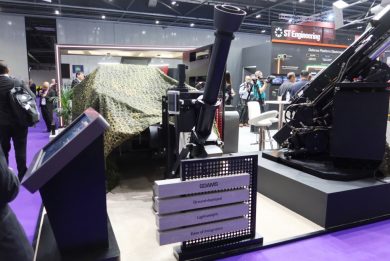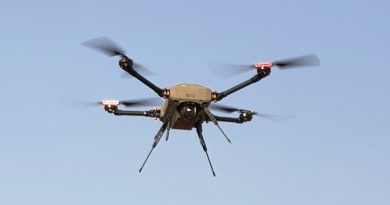
DSEI 2023 – Insitu Tail-Sitting Unmanned Integrator
The Integrator Vertical Take-off and Landing (VTOL) uncrewed aircraft system (UAS) was shown for the first time in Europe at DSEI 2023 by Insitu
Insitu’s Integrator VTOL launches vertically on ships or land without sacrificing payload capacity or endurance. The system retains the performance of fixed-wing aircraft, providing the same long range wide-area surveillance capability for extended periods.
Integrator VTOL is uniquely designed to operate as a portable system in tight quarters, such as ship decks, and in challenging maritime conditions with high seas and gusty winds. No stationary launch and recovery equipment is required – providing expeditionary (ship-to-ship, ship-to-land) portability and modularity across both UAS hardware and payloads while minimising impact to other flight operations.
With greater than 16 hours of endurance carrying 18 kg of modular payloads, the design offers a three-time improvement in range and endurance over hybrid-VTOLs. It also has a significant improvement over tail-sitters in its ability to fly on and off ships in rough seas where ship roll and motion present major issues for tall and narrow base tail-sitter UAS.
The Boeing Company, GKN Aerospace and the Netherlands TNO have jointly developed a distinctive multifunction imaging radar system for the Integrator UAS.
The Integrator’s radar system is based on TNO’s AMBER, Affordable Multi-BEam Radar technology, and combines in real-time simultaneously several ISR functions, including Zoom Synthetic Aperture Radar (ZSAR), Ground Moving Target Indication (GMTI) and Maritime capabilities, into the M-RaISR, Multi-mission Radar Intelligence Surveillance Reconnaissance system.
“Integrator VTOL is a no-compromise uncrewed aircraft system,” said Diane Rose, Insitu president and CEO. “Customers can finally have it all: vertical launch and recovery with industry-leading payload capacity and endurance for their most critical missions, even in the most extreme maritime environments and sea states, without sacrificing valuable transport, deck, or hangar space.”
The system has two parts, the Flying Launch and Recovery System (FLARES) developed by Hood Tech, and the Insitu Integrator unmanned air vehicle. Requiring no modifications to the aircraft, FLARES performs normal operations at half throttle, allowing significant control authority to withstand gusts, lower density air and higher ship deck motion.
To deploy, FLARES engages Integrator and climbs into the sky. Once it reaches its desired altitude, FLARES dashes forward before releasing Integrator, allowing Integrator to perform its long range, wide-area surveillance mission for extended durations. Once Integrator is released, FLARES returns to a ship’s deck or land to await Integrator’s return.
As Integrator approaches at the end of its mission, FLARES again climbs into the sky with a recovery rope attached and performs Insitu’s well-proven maritime retrieval method. FLARES then lowers Integrator to the ship’s deck or the landing area to complete the mission.
Photo courtesy D. Oliver



